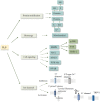The potential role of hydrogen sulfide in cancer cell apoptosis
- PMID: 38448410
- PMCID: PMC10917771
- DOI: 10.1038/s41420-024-01868-w
The potential role of hydrogen sulfide in cancer cell apoptosis
Abstract
For a long time, hydrogen sulfide (H2S) has been considered a toxic compound, but recent studies have found that H2S is the third gaseous signaling molecule which plays a vital role in physiological and pathological conditions. Currently, a large number of studies have shown that H2S mediates apoptosis through multiple signaling pathways to participate in cancer occurrence and development, for example, PI3K/Akt/mTOR and MAPK signaling pathways. Therefore, the regulation of the production and metabolism of H2S to mediate the apoptotic process of cancer cells may improve the effectiveness of cancer treatment. In this review, the role and mechanism of H2S in cancer cell apoptosis in mammals are summarized.
© 2024. The Author(s).
Conflict of interest statement
The authors declare no competing interests.
Figures





References
Publication types
LinkOut - more resources
Full Text Sources
Miscellaneous

